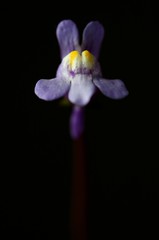
Flower macro
Originally uploaded by Nevoir.
Well after a lengthy unintentional sabbatical from this photo blog its time to resurrect things.
This shot follows a couple of weeks of study around off camera flash. The source of knowledge was inevitably Strobist and the catalyst was buying a set of Elinchrom Skyport radio triggers from the guys at London Flash Centre.
I've been following the Strobist blog for years and always meant to get my head down and follow the lighting 101/ 102 tutorials. It turned out that the best route in for me was to get the strobist dvd and go from there. It is a fantastic learning resource and I found it the best way to join the dots of my patchy knowledge.
This shot was really quick to set up and can be done and dusted in 20 mins.
Anyway, the recipe for this shot is as follows.
You will need:
- Subject
- Something to trigger the flash
- Flash with something to diffuse the light
- Camera + tripod etc...
- Macro lens
1) Set up camera and tripod and choose your first composition with your subject.
2) Choose what you want to focus on while the main light is on as once the lights are out autofocussing becomes almost impossible.
Once you've selected your focus knock the auto focus to manual so that it wont shift. For this shot I chose to focus on the yellow "eyes" as they were an interesting feature.
3) Set up your flash and diffuser (I used a shoot through brolly) and position it as close as you can to the subject (from camera left).
4) Check your flash is triggering and that your subject is getting the light coverage you want.
5) Set your camera to manual mode and set the shutter to its synch speed. My D70 will synch up to 1000th sec but I went for 500th sec for this shot. A super fast shutter will leave you with a really, really under-exposed exposure which gets you that black background (without needing to bother using a piece of black card or whatever).
If you cant synch that fast don't stress, your cameras synch speed should be fast enough to knock the background out as long as your environment isn't too bright.
So your shutter speed gives you your black background and to get the narrow depth of field I chose an aperture of f4. The job of the flash is to illuminate the subject. This point of the shutter controlling the natural or ambient light and the flash controlling the light on the subject is absolutely fundamental to understanding how this stuff works.
6) Set the flash to manual and choose a setting to start with. The final setting on the flash was 1/8th power.
7) Turn the main lights out and set the white balance on the camera to Flash. I shot this at ISO 200 and shot raw files as ever.
8) Take a test shot using a cable release or use the self timer. It's probably not strictly necessary for this sort of shot with flash but its a force of habit and good practice I guess.
9) Check your histogram to see how close you are. If you are too dark either boost the flash power or move it closer if you can. You can also open up the aperture if you want but if you want f4 then change the flash to suit.
Whatever you do don't try and learn about the law of reciprocity which explains how this flash/ subject ratio all works because your eyes will bleed.
10) If you don't like the strong shadow on the right hand of the subject just hold some white card on that side to bounce some light back into the shadows.
This kind of shot is perfect for when the weather is too bad for a landscape session or its dark because you're back from work late and you've just got to create something.